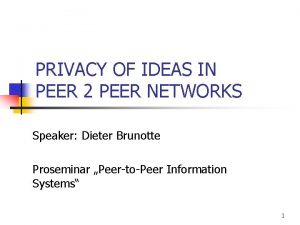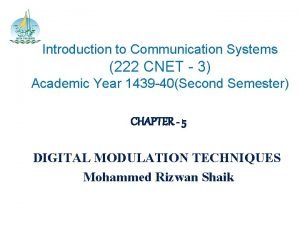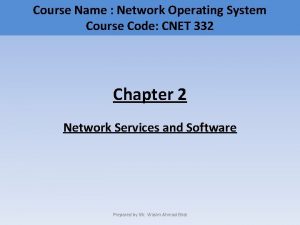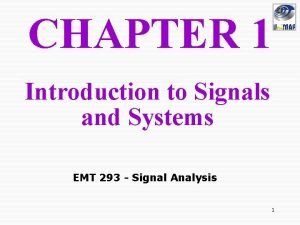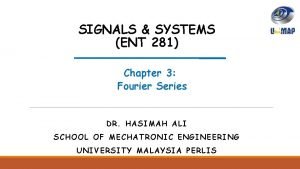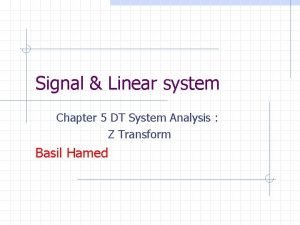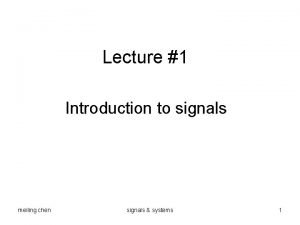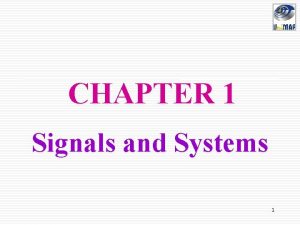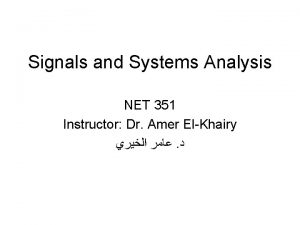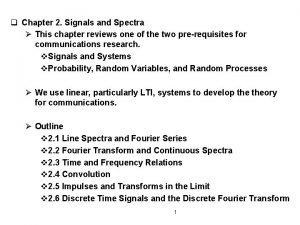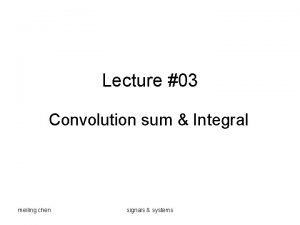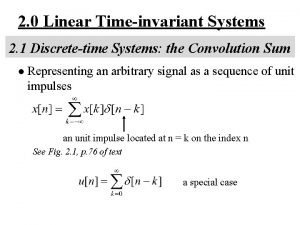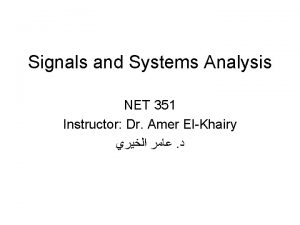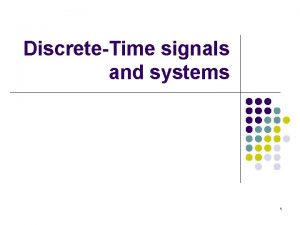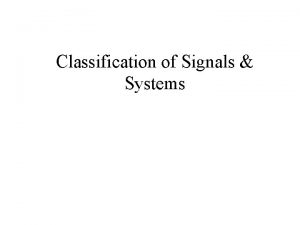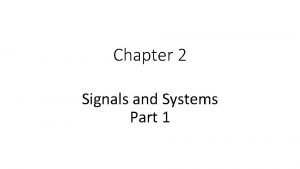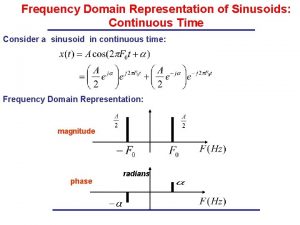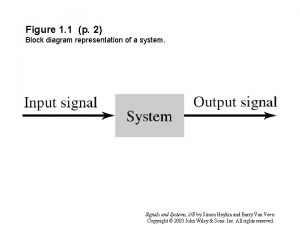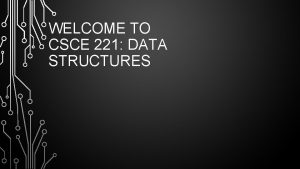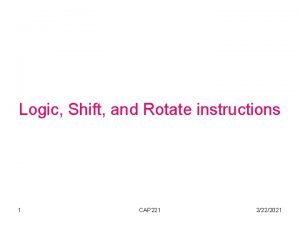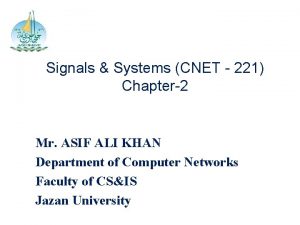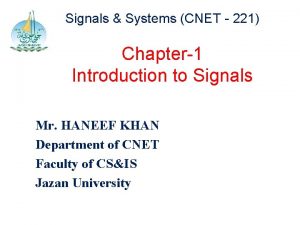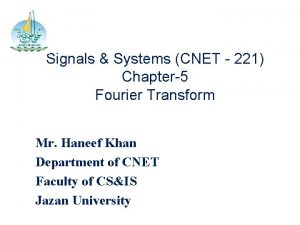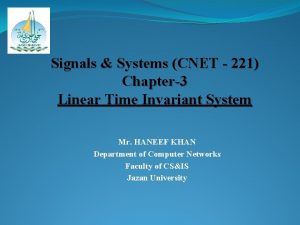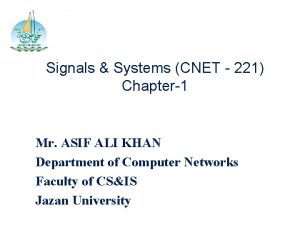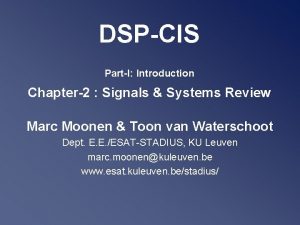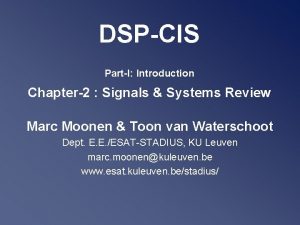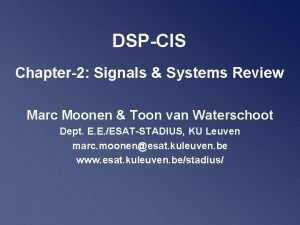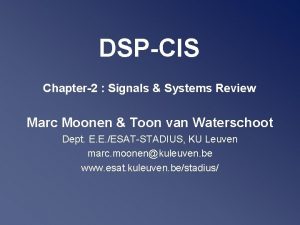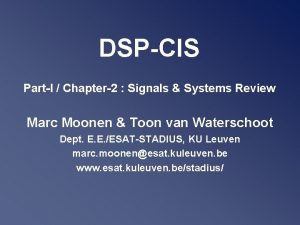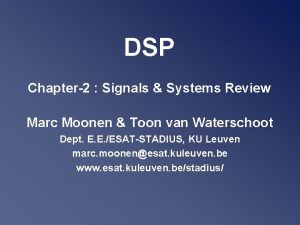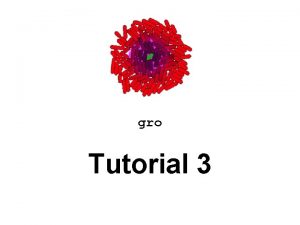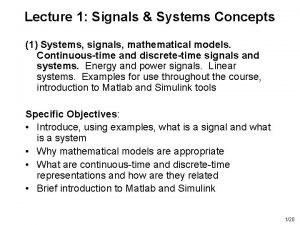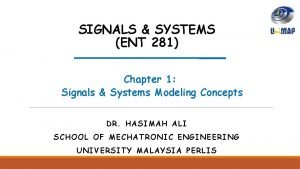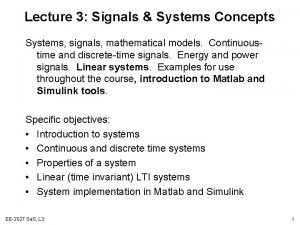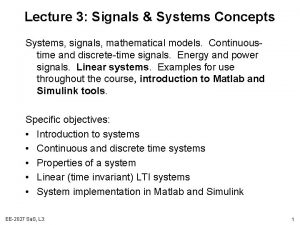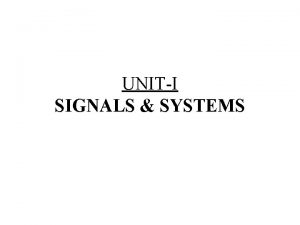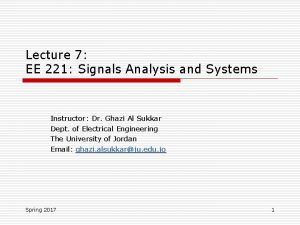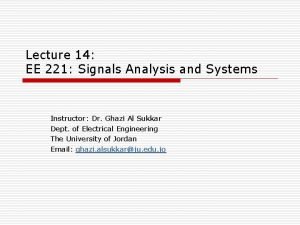Signals Systems CNET 221 Chapter2 Introduction to Systems

























![Impulse Response x(n)= (n) T[] 0 0 h(n)=T[ (n) ] 0 0 Impulse Response x(n)= (n) T[] 0 0 h(n)=T[ (n) ] 0 0](https://slidetodoc.com/presentation_image_h2/5a5967a7a2e35a26617d0762499eb398/image-26.jpg)
![Linear time-Invariant Systems x(n) T[] y(n)=T[x(n) ] Only with the time difference Time k Linear time-Invariant Systems x(n) T[] y(n)=T[x(n) ] Only with the time difference Time k](https://slidetodoc.com/presentation_image_h2/5a5967a7a2e35a26617d0762499eb398/image-27.jpg)
![Convolution Sum (n) T[] x(n) h(n ) y(n) convolution A linear shift-invariant system is Convolution Sum (n) T[] x(n) h(n ) y(n) convolution A linear shift-invariant system is](https://slidetodoc.com/presentation_image_h2/5a5967a7a2e35a26617d0762499eb398/image-28.jpg)

- Slides: 29

Signals & Systems (CNET - 221) Chapter-2 Introduction to Systems Mr. HANEEF KHAN Department of Computer Networks Faculty of CS&IS Jazan University

Chapter Objective Following are the objectives of Chapter-II Ø System Definition, Classification, Representation of different systems including both Continuous and Discrete Ø Basic System properties Ø System verification for both Linearity and Time Invariance Ø Linear Time-Invariant Systems Ø Discrete-Time LTI Systems: The Convolution Sum Ø Representation Of Discrete-Time Signals In Terms Of Impulse Ø Discrete-Time Unit Impulse Response And The Convolution. Sum Representation Of LTI System

Outline-Chapter-2 Introduction to Systems 2. 1 2. 2 2. 3 2. 4 2. 5 Introduction to Systems Continuous-Time and Discrete-Time Systems 2. 2. l Simple Examples of Systems 2. 2. 2 Interconnections of Systems Basic System Properties 2. 3. 1 Systems with and without Memory 2. 3. 2 Invertibility and inverse System 2. 3. 3 Causality 2. 3. 4 Stability 2. 3. 5 Time Invariance 2. 3. 6 Linearity Linear Time-Invariant Systems Discrete-Time LTI Systems 2. 5. 1 Representation of Discrete-Time signals in term impulses 2. 5. 2 Discrete-Time Unit impulse response and convolution

Introduction to Systems What is a System? System is a device or combination of devices, which can operate on signals and produces corresponding response. Input to a system is called as excitation and output from it is called as response. For one or more inputs, the system can have one or more outputs. Example: Communication System

Introduction to Systems(Continued…. . ) Example of various Systems :

Introduction to Systems Continuous-time System: - is a system in which continuous –time input signals are applied and response a continuous-time output signals. Discrete-time System: - is a system in which discrete –time input signals are applied and response a discrete-time output signals.

Basic system properties 1. 2. 3. 4. 5. 6. System with or without memory Invertible Causality Stability or Bounded-input Bounded-output (BIBO) Linearity Time invariance

1. System with or without memory: A system is said to be memory less if the output at any time depends on only the input at that same time. Otherwise, the system is said to have memory. Let x(t) be system input, y(t) - system output. For memory less system, y(t) = f(x(t)), where f is some function. For systems with memory y(t) = ∫ f(τ)x(τ) dτ (integral from 0 to t), that is, the system output at the moment (t) depends not only on x(t), but also on all previous values of x.

2. Invertible: A system is called Invertible if it produces distinct output signals for distinct input signals. If an invertible system produces the output y(t) for the input x(t), then its inverse produces the output x(t) for the input y(t): Examples of invertible systems: Examples of non-invertible systems: y(t) = x(t)2 or y[n] = 0:

3. Causality: Ø A continuous-time or Discrete-time system is called causal if O/P depends upon Past and Present I/P but not Future. Non Causal system : - A system whose present O/P depends on future values of the inputs is called as a non-causal system. All memory less Systems are causal but vice-versa is not true. Examples of causal systems: Examples of non-causal systems: Ex. Planning commission, Weather forecasting.

4. Stability or Bounded-input Bounded-output (BIBO) A system is called stable if it produces bounded outputs for all bounded inputs. (A signal x(t) is bounded if, for some M < ∞, |x(t)| <= M for all t. ) Stability in a physical system generally results from the presence of mechanisms that dissipate energy, such as the resistors in a circuit, friction in a mechanical system, etc.

5. Linearity A system is called linear if its I/O behavior satisfies the Additivity and Scaling properties: Note: - Linear systems have the property that the output is linearly related to the input. Changing the input in a linear way will change the output in the same linear way. T{x 1[n]+x 2[n]}=T{x 1[n]}+T{x 2[n]} ………………Additivity T{a * x [n}= a T{ x [n}…………. Scaling

6. Time invariant Time invariance: A system is called time-invariant if the way it responds to inputs does not change over time: Example: - TV remote control, Keyboard, Microphone.

Time Invariance-Condition

Time Invariance-Numerical Example -1

Time Invariance-Numerical Example -2

Time Invariance-Numerical Example -3

Linearity-Condition

Linearity-Numerical Example-1

Linearity-Numerical Example-2

Linearity-Numerical Example-3

Linear Time Invariant (LTI) Systems • Linearity – Linear system is a system that possesses the property of superposition. • Time Invariance – A system is time invariant if the behavior and characteristics of the system are fixed over time.

Unit Impulse Signal (n) and Unit Step Sequence u(n) 1. Unit-Impulse Signal (n) n -8 -7 -6 -5 -4 -3 -2 -1 1 2 3 4 5 6 7 8 9 10

2. Unit-step sequence u(n) l Fact: u(n) n -8 -7 -6 -5 -4 -3 -2 -1 1 2 3 4 5 6 7 8 9 10

Representation of Discrete-Time Signals in Terms of Impulse x(n) a-3 a 1 2 -8 -7 -6 -5 -4 -3 -2 -1 1 3 4 5 6 a 2 n 7 8 9 10 a 7
![Impulse Response xn n T 0 0 hnT n 0 0 Impulse Response x(n)= (n) T[] 0 0 h(n)=T[ (n) ] 0 0](https://slidetodoc.com/presentation_image_h2/5a5967a7a2e35a26617d0762499eb398/image-26.jpg)
Impulse Response x(n)= (n) T[] 0 0 h(n)=T[ (n) ] 0 0
![Linear timeInvariant Systems xn T ynTxn Only with the time difference Time k Linear time-Invariant Systems x(n) T[] y(n)=T[x(n) ] Only with the time difference Time k](https://slidetodoc.com/presentation_image_h2/5a5967a7a2e35a26617d0762499eb398/image-27.jpg)
Linear time-Invariant Systems x(n) T[] y(n)=T[x(n) ] Only with the time difference Time k impulse The output value at time n Where h is the impulse response
![Convolution Sum n T xn hn yn convolution A linear shiftinvariant system is Convolution Sum (n) T[] x(n) h(n ) y(n) convolution A linear shift-invariant system is](https://slidetodoc.com/presentation_image_h2/5a5967a7a2e35a26617d0762499eb398/image-28.jpg)
Convolution Sum (n) T[] x(n) h(n ) y(n) convolution A linear shift-invariant system is completely characterized by its impulse response.

Videos 1. https: //www. youtube. com/watch? v=7 Z 3 LE 5 u. M 6 Y&list=PLb. MVog. Vj 5 n. JQQZbah 2 u. RZIRZ_9 kfoq. Zyx 2. Signals & Systems Tutorial https: //www. youtube. com/watch? v=y. Lez. P 5 ziz 0 U&list=PL 56 ED 47 DCECCD 69 B 2
 Communicative signals and informative signals
Communicative signals and informative signals Duality in linguistics
Duality in linguistics Communicative signals and informative signals
Communicative signals and informative signals Cnet communication
Cnet communication Visual commerce syndication
Visual commerce syndication Cnet
Cnet Cnet3
Cnet3 Cnet ftp
Cnet ftp Introduction to signals and systems
Introduction to signals and systems Exponential form of sin
Exponential form of sin Signals and systems oppenheim solutions chapter 5
Signals and systems oppenheim solutions chapter 5 Chen
Chen Precedence rule in signals and systems
Precedence rule in signals and systems Convolution sum in signals and systems
Convolution sum in signals and systems Rayleigh energy theorem
Rayleigh energy theorem Convolution sum signals and systems
Convolution sum signals and systems Convolution sum in signals and systems
Convolution sum in signals and systems Signals and system
Signals and system Signals and systems
Signals and systems Classification of signals and systems
Classification of signals and systems Signal and systems
Signal and systems Time frequency domain
Time frequency domain Signals and systems
Signals and systems Csce 221 tamu
Csce 221 tamu Rotational statics
Rotational statics 866-221-0269
866-221-0269 Cap 221
Cap 221 Sp 221
Sp 221 Emmett independent school district
Emmett independent school district Epsc 221
Epsc 221





